2025 Cisco 300-415 dumps exam questions
Share the latest information you need to know for the Cisco 300-415 exam and provide the latest exam questions and answers
300-415 ENSDWI OVERVIEW
Implementing Cisco SD-WAN Solutions (300-415 ENSDWI) v1.2 is a 90-minute exam that tests a candidate's knowledge of Cisco’s Software-Defined Wide Area Network (SD-WAN) solution, including SD-WAN architecture, controller deployment, WAN Edge router deployment, policies, security, quality of service, multicast, and management and operations.
300-415 ENSDWI v1.2 Exam Topics
Implementing Cisco SD-WAN Solutions v1.2 (ENSDWI 300-415) is a 90-minute exam associated with the CCNP Enterprise Certification. This exam tests a candidate's knowledge of Cisco’s SD-WAN solution, including SD-WAN architecture, controller deployment, WAN Edge router deployment, policies, security, quality of service, multicast, and management and operations. The course Implementing Cisco SD-WAN Solutions helps candidates prepare for this exam.
The following topics are general guidelines for the content likely to be included in the exam. However, other related topics may also appear on any specific delivery of the exam. To better reflect the contents of the exam and for clarity purposes, the guidelines below may change at any time without notice.
Architecture 20%
Controller Deployment 15%
Router Deployment 20%
Policies 20%
Security and Quality of Service 15%
Management and Operations 10%
2025 Cisco 300-415 dumps exam questions online share
Question 1:
Refer to the exhibit.
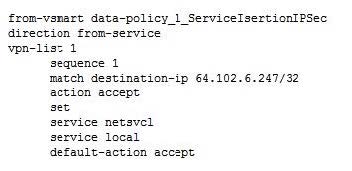
Which configuration configures IPsec tunnels in active and standby?
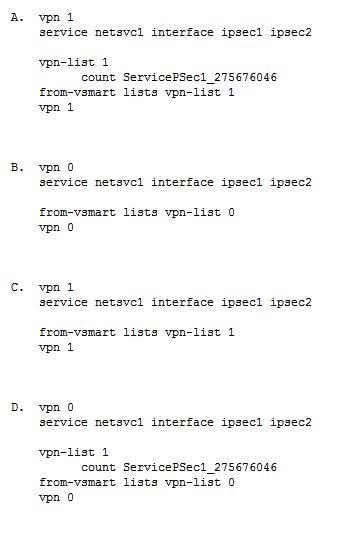
A. Option A
B. Option B
C. Option C
D. Option D
Correct Answer: C
Question 2:
Which type of policy must be applied on a WAN Edge application-aware firewall to control traffic between two or more VPNs?
A. firewall policy
B. data policy
C. service-insertion policy
D. control policy
Correct Answer: A
Question 3:
DRAG DROP
Drag and drop the phases of TrustSec from the left onto the targets on the right. Not all options are used.
Select and Place:
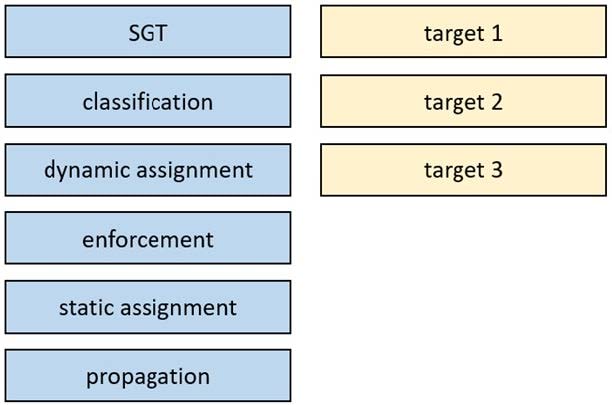
Correct Answer:
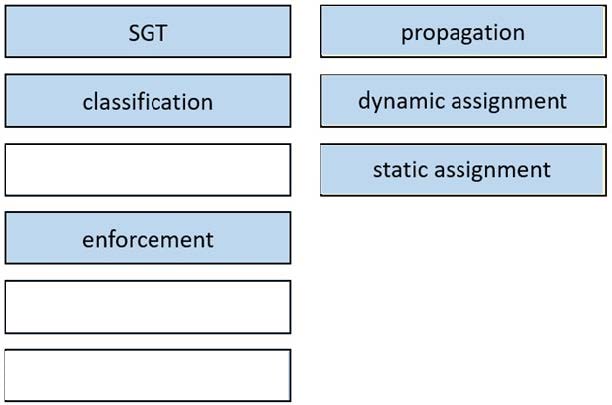
Question 4:
What problem happens on a device with two serial numbers, a unique device identifier (UDI), and secure unique device identifier (SUDI) when an engineer provisions ISR 4000 by PnP using only a UDI?
A. It encounters spanning tree issues
B. It faces interface buffer overflow patterns
C. It encounters redirection problems.
D. It encounters memory overload problems
Correct Answer: C
Question 5:
Which component of the Cisco SD-WAN network assures that only valid customer nodes are participating in the overlay network?
A. vBond
B. vManage
C. vSmart D. WAN Edge
Correct Answer: A
Cisco vBond Orchestrator orchestrates the initial control connection between Cisco vSmart Controllers and edge routers. It creates DTLS tunnels to the Cisco vSmart Controllers and edge routers to authenticate each node that is requesting control plane connectivity. This authentication behavior assures that only valid customer nodes can participate.
Question 6:
Which protocol is used for the vManage to connect to the vSmart Controller hosted in Cloud?
A. PnP Server
B. ZTP
C. NETCONF
D. HTTP
Correct Answer: C
vManage uses NETCONF (TCP 830) to communicate to the controllers, so communication will be unencrypted if there is no DTLS/TLS connection yet formed between them.
Question 7:
How is a TLOC uniquely identified from a WAN Edge router to the SD-WAN transport network?
A. system IP address
B. VPN ID
C. OMP
D. SD-WAN site ID
Correct Answer: A
Question 8:
Which encryption algorithm is used for encrypting SD-WAN data plane traffic?
A. Triple DES
B. IPsec
C. AES-128
D. AES-256 GCM
Correct Answer: D
In the Cisco Catalyst SD-WAN network for unicast traffic, data plane encryption is done by AES-256-GCM, a symmetric-key algorithm that uses the same key to encrypt outgoing packets and to decrypt incoming packets.
Question 9:
Refer to the exhibit.
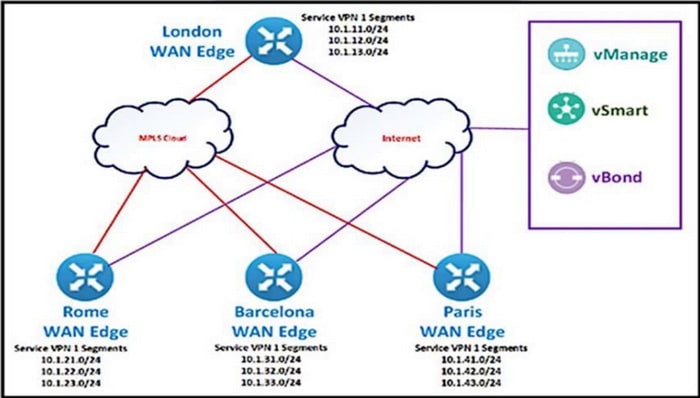
The SD-WAN network is configured with a default full-mesh topology. The network engineer wants the Rome WAN Edge to use the MPLS TLOC as the preferred TLOC when handling Telnet traffic, as long as the MPLS link has the following characteristics:
Loss: 5% Latency: 100 ms Jitter: 100 ms
Which configuration must the network engineer use to create a list that classifies the MPLS link characteristics?
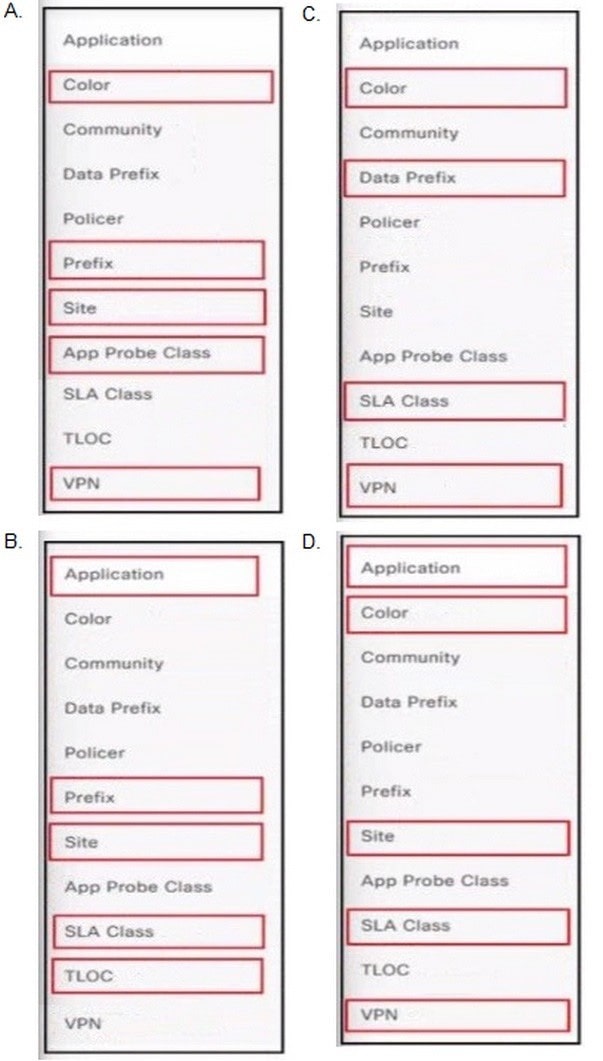
A. Option A
B. Option B
C. Option C
D. Option D
Correct Answer: C
Configuration Analysis: The configurations provided in the images must be evaluated to determine which option correctly classifies the MPLS link based on the given criteria of loss, latency, and jitter. Preferred TLOC Configuration: The network engineer needs to configure the SD-WAN policy to prefer the MPLS transport for Telnet traffic, ensuring the link characteristics match the specified thresholds. References: Cisco SD-WAN Policy Configuration Guide Cisco SD-WAN Transport and TLOC Configuration Guide
Question 10:
Which plane builds and maintains the network topology and makes decisions on traffic flows?
A. data
B. orchestration
C. management
D. control
Correct Answer: D
In Cisco SD-WAN, the plane responsible for building and maintaining the network topology and making decisions on traffic flows is the Control Plane. The Control Plane in Cisco SD-WAN is managed by the vSmart controllers, which are responsible for orchestrating network policies, maintaining the network topology, and making intelligent routing decisions.
Question 11:
What are the two reasons a customer chooses to use IPsec tunnels over GRE? (Choose two.)
A. IPsec failure detection is faster.
B. Generally, they provide a higher bandwidth for tunnel connection.
C. CFlowd is required.
D. A WAN Edge router is behind NAT.
E. IPsec is more secure.
Correct Answer: AE
Question 12:
An engineer must avoid routing loops on the SD-WAN fabric for routes advertised between data center sites. Which BGP loop prevention attribute must be configured on the routers to meet this requirement?
A. static routing on all WAN Edge routers instead of BGP
B. same BGP AS between all CE and PE routers
C. same OMP overlay-as on WAN Edge routers of all data centers
D. same BGP AS between all WAN Edge routers and CE routers
Correct Answer: C
Question 13:
Which routing protocol has the highest default administrative distance?
A. IS-IS
B. OMP
C. IBGP
D. external EIGRP
Correct Answer: B
Administrative Distance
Administrative distance is the metric used to select the best path when there are two or more different routes to the same destination from multiple routing protocols. When the Cisco Catalyst SD-WAN Controller or the router is selecting the OMP route to a destination, it prefers the one with the lowest administrative distance value.
Question 14:
Refer to the exhibit.
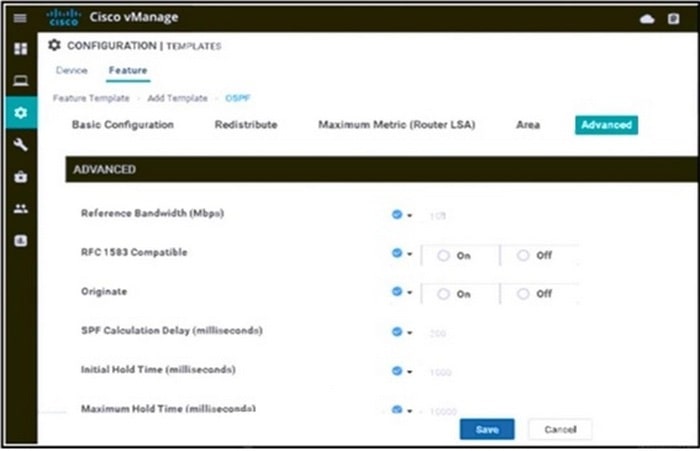
A network administrator is configuring OSPF advanced configuration parameters from a template using the vManage GUI for a branch WAN Edge router to calculate the cost of summary routes to an ASBR.. Which action achieves this configuration?
A. Enable Originate.
B. Disable RFC 1583 Compatible.
C. Disable Originate.
D. Enable RFC 1583 Compatible.
Correct Answer: A
To configure OSPF advanced configuration parameters in the vManage GUI for a branch WAN Edge router to calculate the summary routes to an ASBR, you should select "Enable Originate." Enabling Originate allows the router to advertise summary routes into the OSPF domain.
Question 15:
Refer to the exhibit.
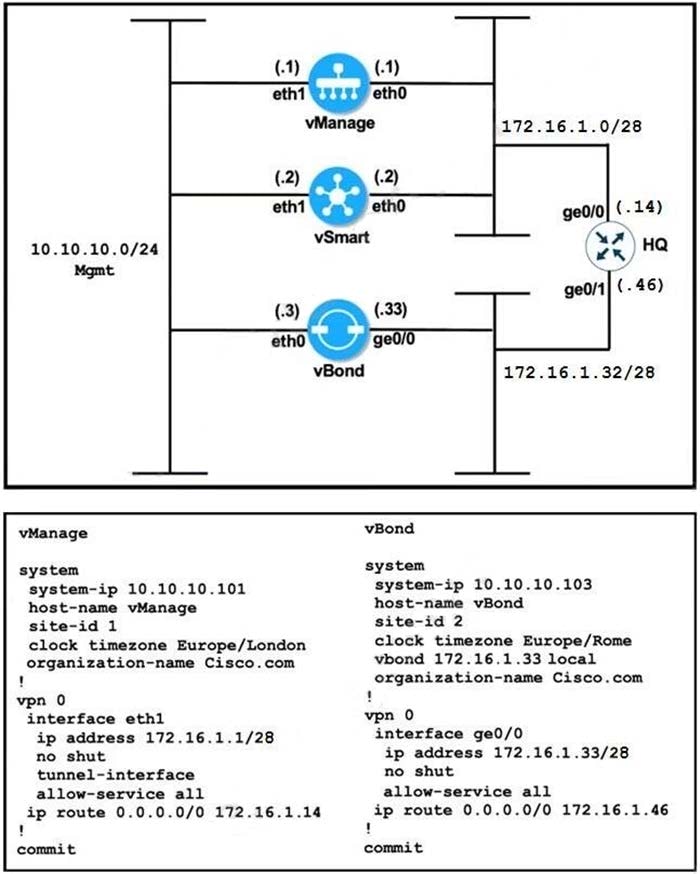
vManage and vBond have an issue establishing a connection to each other. Which configuration resolves the issue?
A. Reconfigure the timezone on vBond to Europe/London.
B. Configure vManage with the vBond address as 172.16.1.33.
C. Configure tunnel interface under interface ge0/0 of vBond.
D. Configure the Site-ID for vBond to 1.
Correct Answer: B
The Leads4pass 300-410 dumps exam material contains 457 latest exam questions and answers. Use https://www.leads4pass.com/300-415.html to download the complete material to help candidates successfully pass the Implementing Cisco SD-WAN Solutions (ENSDWI) exam.
 Knowt
Knowt
